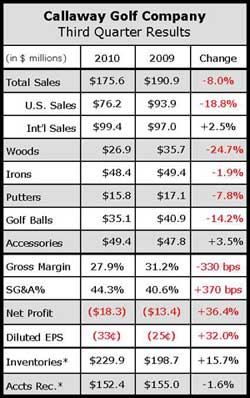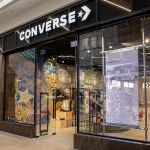After posting a small profit in the second quarter on easy year-ago comparisons Callaway Golf crashed back to reality during the third quarter as cash-strapped consumers continued to avoid big ticket purchases. Company management warned during a second quarter conference call that the market remained sluggish, but it’s probably safe to stay they underestimated just how bad it would be in Q3. The company’s net loss widened to $18.3 million, or 33 cents per share, for the third quarter, nearly double the loss analysts expected and 36.4% worse than the reported loss for the year-ago period.
 The loss per share includes a favorable tax benefit due to a revision to the estimated annual tax rate along with 5 cents in after-tax charges associated with the company’s global operations strategy.
The loss per share includes a favorable tax benefit due to a revision to the estimated annual tax rate along with 5 cents in after-tax charges associated with the company’s global operations strategy.
Overall sales declined 8.0% to $175.6 million on double-digit decreases in the U.S. and Europe and significant revenue declines for the company’s two major segments, Golf Balls and Clubs.
“The sluggish rate of economic recovery continues to plague the golf industry,” suggested Callaway President and CEO George Fellows in a conference with analysts. “The expected rebound in category sales in the U.S. and other major markets throughout the world has not materialized during (2010).” Fellows called the 2010 year-to-date results “very disappointing” and said management at Callaway had overestimated the speed of a potential recovery.
“Uncertainty about the economic recovery and ‘double-dipping’ in the U.S. [along with] euro-zone turmoil and Japanese political and economic unrest has combined to upset recovering trends,” Fellows continued. “As a consequence, the anticipated recovery appears to have been deferred to 2011.” Fellows also pointed to unfavorable weather during the quarter, which contributed to a 4% decline in playable hours in the U.S. and a 4% reduction in rounds played. Also contributing to the revenue decline was the Callaway’s decision to focus less on discounts – which left more unsold merchandise on the shelves – and the adverse timing of certain promotions when compared to the year-ago period.
Fellows added that overall unit volumes decrease for the quarter as consumers continued to defer equipment purchases, although the company did report an increase in average selling prices, which Fellows sees as a sign of the return of a “normal pricing environment” pending the recovery of golf retail. On the subject of strong ASPs, Fellows said green grass locations, which tend to sell higher priced merchandise to more affluent customers, reported better than anticipated sell-through during the quarter, while sales in off-course locations suffered accordingly. In all retail locations, Callaway reported clothing categories outperformed equipment as customers opt for lower selling prices. Also of note, it didn’t seem to help that Callaway is one of the primary sponsors of two PGA Majors champions during 2010, including perennial fan-favorite Phil Mickelson (The Masters) and Irishman Graeme McDowell (U.S. Open).
By product segment, sales in the Irons category dipped 1.9% to $48.4 million, due to a decrease in unit volume. Sales of Putters fell 7.8% to $15.8 million. Golf balls, which management described as a “consumable item,” were directly impacted by the decline in rounds played and fell 14.2% to $35.1 million, while the Accessories business actually saw a 3.5% uptick to $49.4 million for the quarter on strength from women’s Soaire club sets and increases in golf apparel and golf bags. As expected, the highest ticket category, Woods, saw the biggest drop for the quarter, plummeting 24.7% to $26.9 million due to fewer promotional programs at retail.
Fellows noted that driver sales in the year-ago period benefitted from a promotion that gave customers a free fairway wood or hybrid with the purchase of a regular-priced driver.
Despite fewer discounted sales, gross margins for the quarter declined 330 basis points to 27.9% of sales due to increased charges associated with the aforementioned global operations initiatives, negative fixed-cost absorption due to lower volumes and non-cash inventory charges.
By region, U.S. sales fell 18.8% to $76.2 million again Europe sales fell 13.4% to $23.4 million. Strong growth from Japan (+25.9% to $36.7 million) and improvement from the Rest of Asia (+2.3% to $21.5 million) propelled overall International sales to low-single-digit growth.
The company declined to give specific guidance for the balance of the year, although management expects sales from new products in the fourth quarter to be less than in 2009 due to fewer products being released during the period.















